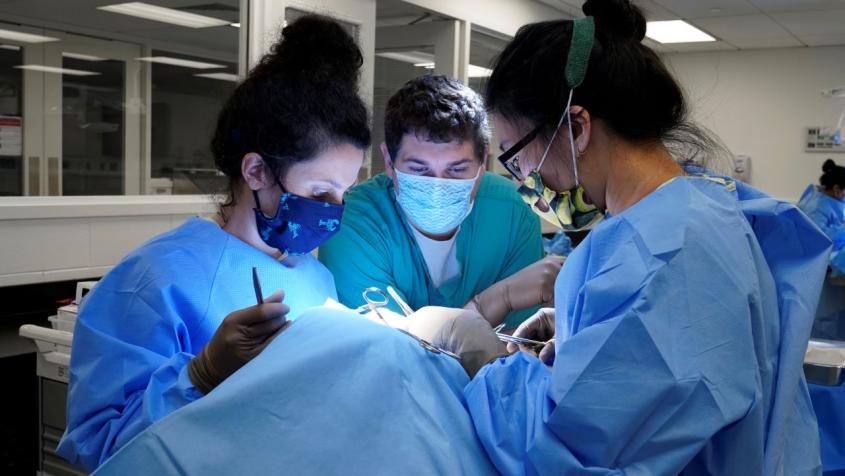Gender disparities in veterinary internships, residencies stem from unbalanced opportunities
When Daniel Lopez ’12, D.V.M. ’16, first began teaching as a faculty member at the College of Veterinary Medicine (CVM), an interesting pattern caught his attention. The assistant clinical professor in the Department of Clinical Sciences and his colleagues noticed that male residents in small animal surgery seemed to have come directly from a rotating internship, while female residents appeared to have completed more internships to get to the same position. “This struck us as peculiar, but we didn’t know if it was a broad theme or not,” Lopez said.
This observation led to a study — co-authored by Lopez and several CVM colleagues — that was recently published in the journal Veterinary Surgery, exploring whether gender plays a role in an individual’s ability to move directly from a rotating internship to a residency. The paper is part of a larger body of work on gender in veterinary medicine, and specifically in small animal surgery, that has emerged from CVM over the past years.
“This project fits in like a puzzle piece to some of what I and other researchers have done previously, and it helps shape the picture of where future projects need to go,” said Sam Morello ’02, D.V.M. ’06, one of the paper’s authors and a courtesy associate professor with CVM’s Center for Veterinary Business and Entrepreneurship (CVBE).
A previous study by Morello had found that men and women were equally successful in matching into various specialty residency programs — including small animal surgery — when they applied, but men were generally more likely to apply to competitive residencies. The recent research led by Lopez “strengthened and drilled down into these findings, corroborating them through using a different methodology,” Morello said.
Lopez and surgery resident Dr. Mikayla Schroeder designed the study to look closely at applicants to small animal surgery residency programs, considering social factors like race and qualifications like the number of internships completed, academic record and number of publications. During data evaluation of the 100 survey respondents, Lopez and then-veterinary student Jenna Menard, D.V.M. ’23, first author of the study, found that men were more likely to match directly into a residency program compared to women, supporting Lopez’s initial observation.
To the researchers’ surprise, gender did not appear to be the underlying factor. “Women got to the finish line as often as men, but it took them a bit longer to do so,” Morello explained. “This difference was driven by one specific factor — research productivity.” Men were more likely to be authors on manuscripts than women.
While gender may not be the immediate reason why women take longer to place into residency programs — and the authors do not recommend applicants’ gender be hidden from evaluators — it may still play a role through implicit bias. “The difference may be in the opportunities that were provided to women, which of course may still be gender-influenced,” Lopez said. Another recent study by Morello, for example, showed that more research collaboration tends to take place between men than between women or between men and women. Female veterinarians may thereby miss out on potentially career-advancing and confidence-building mentorship, especially because — according to more research by Morello — currently men make more money and hold more prestigious titles than women in veterinary medicine.
“All of these individual studies fit together to help explain a bigger picture of what’s going on in vet med,” Morello said. “I think it’s important for people to think of gender — and other identities — in terms of systems and policies we’ve created that are or are not fit for the various people who operate within them.” This structural view of gender ties directly into her broader work at CVBE. “Understanding how finances intersect with gender and also with other racial, ethnic or identity groups — and they definitely do — is a key part of understanding how the workforce operates, and therefore how businesses can be successful,” she said.
The recent studies also lay a foundation for possible changes that can lead to more equity. Evaluators in surgical residency and surgeon programs, on the one hand, should become aware of and take into account the unbalanced professional opportunities available to men and women, according to Lopez. On the other hand, “We really want to emphasize making sure that there are equal chances between genders for obtaining those qualifications,” he said. Organizations such as the Association of Women Veterinary Surgeons, founded by Dr. Nicole Buote, associate professor in the Department of Clinical Sciences and another co-author of the Lopez paper, have made this part of their mission.
Many changes have already gained traction. Morello points to more workplaces offering shorter work weeks and flexible schedules and providing paid parental leave in a way that supports and does not hinder an individual’s career. “Still, there are many places where few to none of these changes have happened, so there’s still a long way to go,” she said. But she is hopeful that the work she and her colleagues are doing will make an impact. “I decided that, for me, researching gender, careers, personal lives and how all these things intersected was the best way to support a future generation and our sustainability in general.”
Written by Olivia Hall





